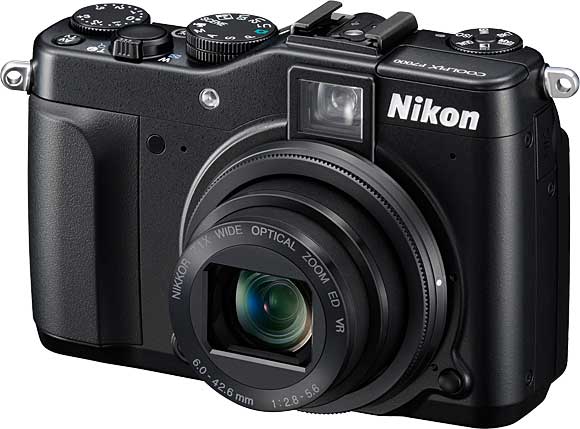Review Date: November 7, 2010
Category: Serious Amateur

USER’S EXPERIENCE
Friday, October 15, 2010 – Here’s what I receive in the box:
- Nikon P7000
- No memory card [I received a 2GB SD card for the review]
- Li-ion Battery EN-EL14 7.4V 1030mAh 7.7Wh
- Battery Charger MH-24
- Neck Strap
- USB Cable and A/V Cable
- Documentation: User’s Manual
- Software CD: ViewNX2
Nikon returns to the compact system category with the Coolpix P7000 and takes direct aim at the Panasonic LX5 and Canon G12. The Nikon P7000 is certainly an impressive camera choke-full of features, dials and buttons, aiming to be the choice of serious and advanced photographers whenever they decide to leave their DSLRs home.
First impressions of the P7000 is that it is bristling with dials. In fact, there are only 3 dials, but it looks like there are at least half a dozen. At first, you may have a hard time figuring out where to find a particular function but after using them for a couple of days, it all becomes second nature.
My take with dials is that I should be able to rotate a dial to a setting and it’s set. Examples of such dials are: Mode dial, Shutter Speed dial, Aperture Ring, ISO dial. Rotate and it’s set. I beleive that should be the only time a dial is introduced on a camera.
Does the P7000 have these 4 dials? It has the Mode Dial, the Command Dial acts as the Shutter Speed dial, and the Rotary Multi Selector as the Aperture Ring. The only dial missing on the P7000 is the ISO dial.
The Quick Menu Dial, on the other hand, requires that you not only rotate the dial to select a function, but you then need to press the Quick Menu button in the middle to bring up a sub-menu of that function, then rotate the Command Dial to make a selection. The Quick Menu Dial does not gain the photographer anything since it does not ascribe to the “rotate and it’s set” principle. My improvement suggestion is to convert the Quick Dial to an ISO dial and simply provide a Quick Menu button.
All these external dials and buttons mean you spend less time in the Menu. The following three functions are important enough to justify having their own buttons; however, they are only accessible through the Menu:
- To select a Drive mode (Single, Continuous, BSS, Continuous flash, Multi-shot 16, Intvl timer shooting), you need to access the Menu [Menu – Shooting menu – Continuous].
- To turn the Image Stabilization (Vibration Reduction) on or off, you need to access the Menu [Menu – Set up – Vibration reduction].
- Unless you’ve customize the Fn button to bring up the ND Filter, to use the ND Filter, you need to access the Menu [Menu – Set up – Built-in ND filter – On, Auto, Off].
These may or may not be important to you, depending on your shooting style and needs.
The P7000 has a Live Histogram. This is cause for celebration since past models only had one in Playback mode.
Another cause for celebration (for me) is the Virtual Horizon. If you’ve paid attention to my pictures, you know I am extremely challenged when it comes to keeping the horizon well, horizontal. You know what I would really like to see in future cameras? An Auto Horizon function that, once set, will rotate the image for me to keep it horizontal. Shouldn’t be hard to implement.
The Nikon P7000 startup is blazing fast at around 1 sec. (Nikon lists 0.9 sec.) and it does not have a practical shutter lag, which means that you won’t miss capturing the moment when you press the shutter release button. Add in all those external dials and buttons — and you have one camera that enthusiasts will find compelling and fast to use.
However,… the overall user experience tells a slightly different story. It takes 2-3 sec. to exit from the Playback screen or when coming out of the Menu, 2.5 sec. to write a JPEG to memory card, 5 sec. to write a RAW file to memeory card, and you often find yourself too close to the subject and the camera won’t lock focus. You just don’t get that instant feeling in all its operation that you expect from a top-of-the-line camera.
When the AF cannot lock, 5 unsuccessful tries in a row will display a nasty “Initializing lens. Cannot focus.” error message.
The shutter speed range is from 60s to 1/4000s, but unfortunately this range is not available in all the shooting modes and it varies with the ISO and aperture. For example, in M mode and at ISO 100, it’s from 60s to 1/4000s (the full range) at F8.0, but from 60s to 1/2000s at F2.8. You’d think, it should be the reverse since at a larger aperture, you may need the faster shutter speed for a correct exposure. Change the aperture and/or the ISO, and the shutter speed range changes in all the shooting modes. It can be perplexing because the limitations mean you can never be sure what shutter speed range you have to work with.
A landscape photographer will not mind any of these limitations. A street photographer might. So whether the Nikon P7000 is the right camera for you or not depends on your type of photography. The serious photographer should also carefully consider whether the flexibility of being able to use interchangeable lenses that the new compact mirrorless DIL cameras provide is important to them.
A detailed User’s Manual is provided in print. It is well written and illustrated, and it is easy enough to quickly find what you are searching for.

I like the ViewNX 2 software and you can display the EXIF Info right on the same screen (right column). It will also transfer NRW (RAW) files and movie files and allow you to view, edit and save them. Yes, NRW files can be processed either in-camera or in ViewNX 2: you can modify exposure compensation, white balance, picture control, sharpness, contrast and brightness. You can also purchase the optional CaptureNX 2 for more fine control of NRW files. Improvement suggestion: provide option to change the depressing grey background color (whole screen, not just the thumbnails window).
What I like about the P7000:
- Very good image quality from ISO 100 to ISO 400.
- Good zoom range from wide-angle to medium tele.
- Lots of external dials and buttons mean less reliance on Menu.
- Very good build.
- High resolution LCD screen.
- LCD gains up very well in low-light, one of the best I’ve used.
- Optical viewfinder for those who need one.
No review is complete without a couple of improvement suggestions:
- Improve AF speed.
- Improve Playback, Menu and file writing performance.
- Decrease minimum camera to subject focus distance.
- Provide the full shutter speed range in all PASM modes, irrespective of aperture and ISO selected.
- Put in a tiltable LCD (no serious camera should be without one).
The Nikon P7000 takes very good pictures, has all those external dials and buttons that make photography more enjoyable and is choke-full of features to help you meet any photographic challenge. It’s the best compact Nikon has built to-date and is a formidable instrument in the hands of a serious photographer. To them, bearing in mind the limitations in AF and shutter speed range I mentioned earlier and if they do not require the interchangeable lenses that compact mirrorless DIL cameras provide, it is Highly Recommended.
Next: Nikon P7000 QuickFact Sheet / Buy


















